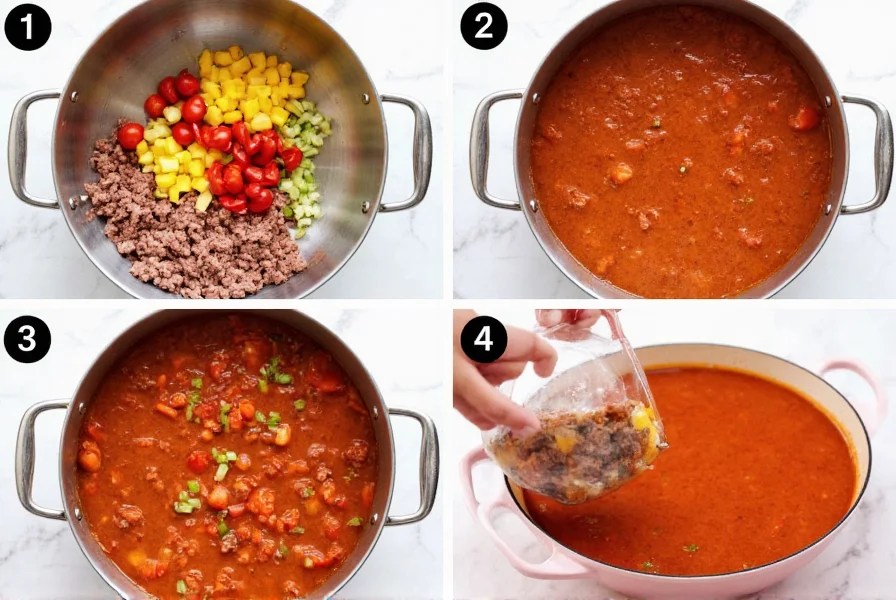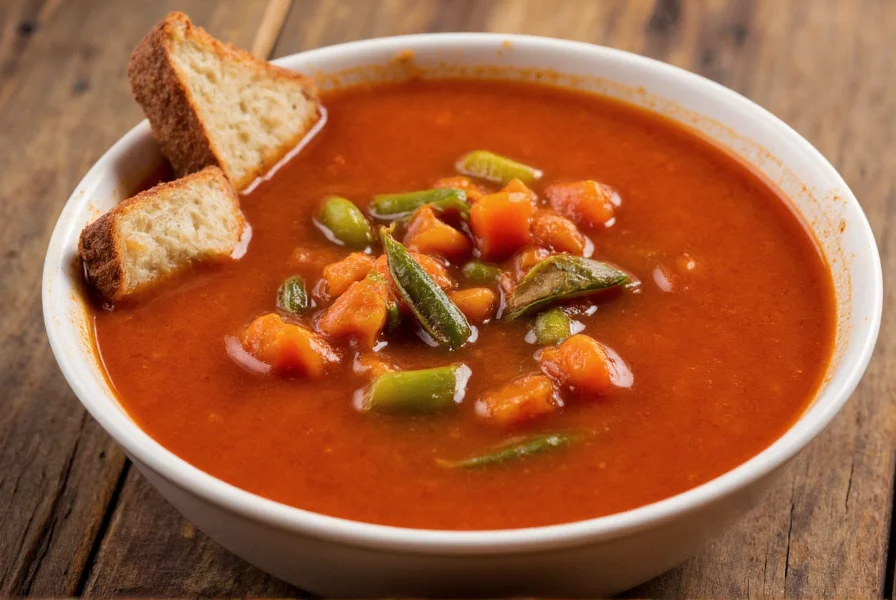What Makes Stuffed Pepper Soup Special
Stuffed pepper soup transforms the classic stuffed pepper concept into a comforting, easy-to-prepare meal. While traditional stuffed peppers involve hollowing out bell peppers and filling them with a mixture of ground meat, rice, and tomatoes before baking, the soup version combines all these elements in a single pot. This adaptation maintains the signature flavor profile while eliminating the time-consuming preparation of individual peppers.
The beauty of easy stuffed pepper soup recipe variations lies in their flexibility. You can customize ingredients based on dietary preferences or what's available in your pantry. The base components typically include:
- Ground beef or alternative protein
- Bell peppers (various colors)
- Rice (white, brown, or cauliflower rice)
- Tomato products (diced tomatoes, tomato sauce)
- Aromatic vegetables (onion, garlic)
- Beef or vegetable broth
- Classic seasonings (paprika, oregano, Worcestershire sauce)
Traditional Stuffed Pepper Soup Recipe
Creating a healthy stuffed pepper soup that satisfies without excess calories is simpler than you might think. Here's a balanced approach that delivers maximum flavor with thoughtful ingredient choices:
| Ingredient | Amount | Preparation Notes |
|---|---|---|
| Lean ground beef (90% lean) | 1 pound | Brown thoroughly, drain excess fat |
| Bell peppers (mixed colors) | 3 medium | Diced into 1/2-inch pieces |
| Yellow onion | 1 medium | Finely chopped |
| Garlic cloves | 3 | Minced |
| Diced tomatoes | 28 oz can | With juices |
| Beef broth | 4 cups | Low sodium preferred |
| Long grain rice | 1/2 cup | Rinsed before adding |
| Tomato sauce | 8 oz can | For richer flavor |
| Paprika | 1 tsp | Sweet or smoked |
| Dried oregano | 1 tsp | Crushed between fingers |
Step-by-Step Preparation
Follow these steps for the best stuffed pepper soup with rice that maintains perfect texture and flavor balance:
- Brown the meat: In a large pot or Dutch oven over medium-high heat, cook ground beef until no pink remains. Drain excess fat and return to pot.
- Sauté vegetables: Add onions and bell peppers to the pot. Cook for 5-7 minutes until softened but still retaining some crunch.
- Add aromatics: Stir in minced garlic, paprika, and oregano. Cook for 1 minute until fragrant.
- Build the broth: Pour in diced tomatoes with juices, tomato sauce, and beef broth. Stir well to combine.
- Add rice: Incorporate rinsed rice, bring to a boil, then reduce heat to low.
- Simmer: Cover and simmer for 20-25 minutes, or until rice is tender and soup has thickened slightly.
- Final seasoning: Stir in Worcestershire sauce, salt, and black pepper to taste. For extra richness, add a splash of heavy cream if desired.
Customizing Your Stuffed Pepper Soup
One of the greatest advantages of this ground beef stuffed pepper soup recipe is its adaptability. Consider these variations to suit different dietary needs and preferences:
Vegetarian Alternative
For a vegetarian stuffed pepper soup alternative, substitute the ground beef with:
- 1 cup cooked lentils
- 1 package plant-based ground "meat"
- 1 cup chopped mushrooms and walnuts
Use vegetable broth instead of beef broth and increase the tomato products slightly for depth of flavor.
Dietary Modifications
Low-carb version: Replace rice with cauliflower rice, adding it during the last 5-7 minutes of cooking to prevent overcooking.
Creamy variation: For a creamy stuffed pepper soup variations, stir in 1/2 cup heavy cream or coconut milk during the last 5 minutes of cooking.

Common Mistakes to Avoid
Even experienced cooks can make errors when preparing how to make stuffed pepper soup in 30 minutes. Watch out for these common pitfalls:
- Overcooking the rice: Adding rice too early results in mushy texture. If meal prepping, cook rice separately and add when reheating.
- Skipping the meat browning: Properly browning ground beef develops flavor through the Maillard reaction.
- Using sweet bell peppers only: Combine different colored peppers for more complex flavor.
- Underseasoning: Stuffed pepper soup needs adequate seasoning to balance the acidity of tomatoes.
Serving and Storage Tips
Maximize your stuffed pepper soup experience with these professional recommendations:
- Serving: Ladle hot soup into pre-warmed bowls. Top with fresh parsley, grated Parmesan, or a dollop of sour cream.
- Pairing: Serve with crusty bread or a simple green salad for a complete meal.
- Storage: Cool completely before transferring to airtight containers. Refrigerate for up to 4 days.
- Freezing: Freeze without dairy additions for best results. Thaw overnight in refrigerator before reheating.
- Reheating: Warm gently over medium-low heat, adding a splash of broth if needed to restore consistency.

Frequently Asked Questions
Can I make stuffed pepper soup without rice?
Yes, you can make stuffed pepper soup without rice. Substitute with quinoa, cauliflower rice, or simply omit the grain entirely. If omitting rice, reduce the broth by 1 cup to maintain proper soup consistency. For a thicker texture without grains, add an extra 1/2 cup of tomato sauce or puree.
How do I prevent bell peppers from becoming mushy in the soup?
To maintain pepper texture, add them later in the cooking process. Sauté onions first, then add bell peppers during the last 7-10 minutes of simmering. For even better results, reserve 1/4 of your diced peppers and add them during the final 5 minutes of cooking. This technique preserves their vibrant color and provides pleasant textural contrast in each spoonful.
What's the best way to make stuffed pepper soup ahead of time?
For optimal results when meal prepping stuffed pepper soup, prepare the base without rice or pasta. Cool completely, then store in airtight containers for up to 3 days. When ready to serve, reheat the soup base, add freshly cooked rice, and simmer for 5 minutes. This prevents the rice from becoming overly soft during storage. Alternatively, cook rice separately and add it to individual portions when serving.
Can I use different types of meat in stuffed pepper soup?
Absolutely. While ground beef is traditional, you can use ground turkey, chicken, pork, or Italian sausage for different flavor profiles. For a richer taste, try a 50/50 blend of ground beef and Italian sausage. If using leaner meats like turkey or chicken, consider adding 1 tablespoon of olive oil during the browning process to prevent sticking and enhance flavor development.











 浙公网安备
33010002000092号
浙公网安备
33010002000092号 浙B2-20120091-4
浙B2-20120091-4